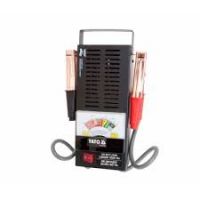Hello
I need a simple tester to check the dry condition of the batteries.
The tester is to simulate the start of the car if the battery voltage does not drop below 10V.
Construction: a piece of wire on the section of which resistors or other components giving an artificial load will be attached.
The problem is choosing the right load value. I have browsed a few topics with inrush current and some say that the starter takes 100-150A from the battery, and others that 300-350A.
Another problem is that at the moment of start-up, these values jump significantly because many factors of work change, and with such an artificial load, the current is constant.
What value will be the most optimal for such a test?
On the one hand, I want to get a strong load so that the measurement is reliable, and on the other hand, I don't want to finish the battery.
I will add that the measurement length would take about 5 seconds for the multimeter to have a moment to stabilize the values.
I need a simple tester to check the dry condition of the batteries.
The tester is to simulate the start of the car if the battery voltage does not drop below 10V.
Construction: a piece of wire on the section of which resistors or other components giving an artificial load will be attached.
The problem is choosing the right load value. I have browsed a few topics with inrush current and some say that the starter takes 100-150A from the battery, and others that 300-350A.
Another problem is that at the moment of start-up, these values jump significantly because many factors of work change, and with such an artificial load, the current is constant.
What value will be the most optimal for such a test?
On the one hand, I want to get a strong load so that the measurement is reliable, and on the other hand, I don't want to finish the battery.
I will add that the measurement length would take about 5 seconds for the multimeter to have a moment to stabilize the values.



